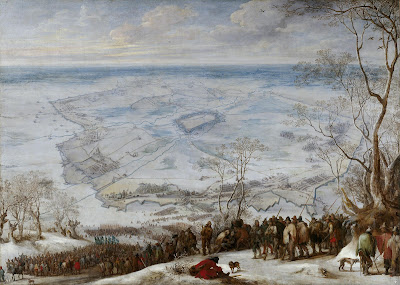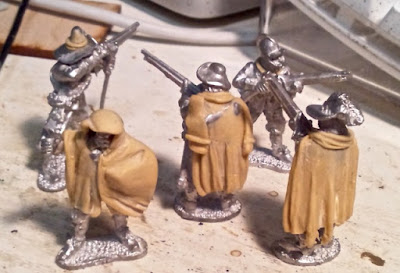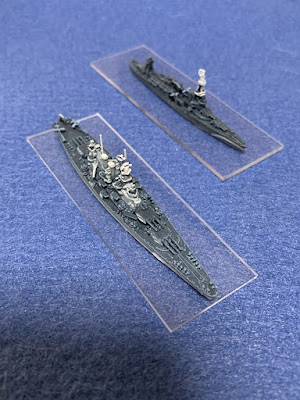Tercio de Barón de Gramont; el ejército español de Flandes 1642-48

*****
A new period for the blog, but not really a new project- just a newly-unveiled one.
The Thirty Year's War has long been one of those pet interests of mine. But for some reason or another, it never really got off the ground- mostly due to a resounding lack of interest from other gamers. Interest in the Pike & Shot era has usually been limited to the ECW- when there was any interest at all. Most often there wasn't.
This is actually a third incarnation of my TYW efforts, the first being a (now long gone) Swedish army in 15mm back in the 1980's using Freikorps 15/ Minifigs, and the second never really getting past a few packs of Foundry figures in 25mm.
Finding a decent set of rules has always been an issue- typical 70's and 80's fare like WRG and the obscenely complex Tercio really didn't grab the attention of my gaming circle at the time- me included.
But third time lucky.
This time the plan is to do a later Imperial Spanish army, from post-Nordlingen to Rocroi/ Lens. Swedes were off the list this time, as there always seems too much controversy about both tactics and costume.
And for me, the Spanish were a natural choice. One of my fondest memories of UBC back in Vancouver was taking a European history undergraduate course, where we were lucky enough to have been lectured by a visiting professor from St. Andrews University, Geoffrey Parker.
Professer Parker is a leading authority on the Dutch Revolt, Thirty Years War, and on the Spanish Netherlands in particular. A good dose of military as well as political and social history kept me well and truly engaged. He was an inspiring lecturer and very accessible to undergraduates (in contrast to many other leading lights of academia who had to interact with us unwashed masses). His lectures on the TYW included everything from geo-political context to demonstrations of pike drill, so I was well and truly hooked on the army of Spain and the Spanish Road.
Unfortunately, when I decided to start this project back in 2015, there were no dedicated figures out there for TYW Spanish. Not so now, given the wonderful range recently produced by 1898 Minuaturas and also available through Empress Miniatures.
But long ago I had inherited a bunch of ECW miniatures from Bicorne and Renegade, along with a few from Redoubt. These were way bigger than Foundry and Perry, but I liked them- the Bicorne/ Renegade sculpts in particular- although all three manufactures needed some major cleaning up.
Despite the excellent sculpting of the range by Nick Collier, Renegade were going through one of their many (and eventually terminal) crises at the time, the moulds were the worst for wear and the figures had a lot of flash. Redoubt in their turn were a mixed bag; stylistically varied and really huge. Some were great, others aren't worth even trying to remove the flash. However, they had a useful range of separate heads, including helmets and some wonderfully-voluminous floppy hats.
Most TYW miniatures on the market these days are for the earlier part of the war, from Bohemia up to Lutzen. As has ever been the case fashions did change, and I think few wargamers out there would be willing to use, say, 1914 BEF infantry in a 1944 Normandy scenario.
Thirty years is a long time, and Rocroi was fought during the later "French
Phase" of the conflict, at about the same time as the First English Civil War. By
the mid-1640’s the earlier "frilly" neck ruffs were on their way out and breeches were becoming more tubular than was the case
earlier. Cravats were beginning to replace the earlier
stand-and-fall collars, and the doublet was rapidly falling out of style. Fortunately for me, the Spanish tended to dress
more conservatively than the ever-fashion-conscious French, so I can make use of quite a few figures meant for the earlier period.
Armour was being lightened but probably more was worn on the continent than in the Civil Wars.
So with a bit of cherry-picking, I found that many ECW figures I had could pass muster as TYW infantry, although with some caveats.
Most of the figures had (appropriately) been sculpted wearing either knitted Monmouth caps or monteroes. Okay for the French, who could be seen wearing a similar hat to the montero, but with more plumage, called a boukinhan- spelling seems to vary. Indeed Redoubt does a nice one- on those rare occasions it has been properly cast. But these appear relatively rarely in contemporary paintings of the Spanish army in action, where brimmed hats of various sizes predominate. These hats also tended to have taller crowns than what was the fashion in the British Isles.
Quite aside from wanting to make the best use of the miniatures I had to hand, I'm just too anal to just proxy ECW figures for TYW Spanish-Imperial troops "as is", without putting in at least some effort at making them look a bit more historically accurate.
Besides, converting the figures would allow me to field an army that is set apart a bit from a lot of the ones I see online, many making use of the ubiquitous (and questionable) Warlord plastics.
So turning to the minis, I sorted out the ones that would need surgery; out came the clippers and off went their scalps, to be replaced by new heads or floppy hats.
I started by doing a few head swops and, using some Tamiya epoxy putty (cheap as chips here in Tokyo), I added some rough cloaks, new hats, cassocks, ribbons, etc. that also gave them more of that "ragged campaigner" look. And the cloaks can hide a multitude of sins.
I hadn't intended to do a lot of these, just a few to throw in on each stand for variety. But it was an addictive activity, so now a good third or more of my collection has been modified to some extent or another.
It was tricky business at first, but with experience and through trial and error it got a lot easier.
I did add more miniatures as time went on- Horcata, more Bicorne, and even Warlord. As a general rule for the TYW German/ Imperialist armies, I would want to get as many figures wearing cassocks as I could get my hands on (Warlord actually do really well here with a very nice pack of veteran musketeers (in metal- their plastics, frankly, suck).
I originally intended these to be Spanish tercios, but decided instead to painted up and flag them to represent the Walloon/ Burgundian and German units that will make up much of the army. I'll order the Spanish proper from Empress once funds allow, and the painting queue gets shorter.
It will take time, for it is not a mainstream period among gamers here (no khaki or internal-combustion engines); thus I will need to do both sides. I've another
Spanish unit to finish and then it's on the Bourbon hordes. These will
consist of both French and Weimarian troops.
*****
Uniforms and painting: In the 1640's there was still no (official) uniformity in the Spanish army, partly out of traditional preference by the veterans, but also not surprising given the dire financial straits of the Spanish state at the time.
That said, a captain was responsible for seeing that his company was decently outfitted and properly equipped (or at least not in absolute rags). Consequently, he would on occasion arrange for purchasing bolts of cloth or even sets of clothing for his men (and certainly for any recruits) after time and campaigning had taken its toll. Thus individual companies in the tercios might actually present a more uniform appearance, although with some variation.
As to the colour of any material procured in this way, I strongly suspect it would have been subject to cost, availability, and lastly the individual whim of the company captain. There were certainly no official guidelines.
To reflect all this, I've been grouping figures together on the stands so that some files or ranks of between two to four figures might have the same colour jacket and/or breeches, although hat colour is pretty random.
For inspiration, I closely observed the excellent and inspiring paintings by Peter Snayers and his studio, done in the 1640's and 1650's.
 |
| French troops the Battle of La Marfee, 1641 |
 |
| Ragged French infantry |
 |
| The Spanish victory at Honnecourt, 1642 |
These are an amazing series of topographical paintings of various battles involving Imperial armies of the TYW. On display at the Prado Art Gallery in Madrid, which has a website where you can look at the paintings online and zoom on the images to reveal an amazing amount of detail.
Whether the actual colours used were really representative of how the armies of the time looked, I don't know; but certainly they give a good indication of what colours would be considered plausible- in most cases nondescript browns, greys, dull blues and ochres.
As a bit of artistic license (this is just a pastime, after all), and to tie the whole unit together given the lack of uniformity, I have been giving my Spanish Imperial troops red stockings, with red and yellow lacing just as a device to aid identification on the tabletop.
These of course were a gift given annually to the brigade from Dona Isabella el Saliva d'Aquavelva, Marquesa del Marsupial y Cuspidor as a mark of distinction for their valour during the storming of Venlo in 1637; where, after the last of repeated costly assaults on the breached defenses, the victorious survivors were seen to have immediately fallen onto their knees, staining their stockings in their own blood, as they offered up prayers of thanks to the Holy Virgin Mother for their victory and salvation.
You really can't make up stuff like that.
Well, actually, you can...
Regarding flags, we have no information on what colours were flown by Gramont's tercio, I had asked Iain at Flags of War. if he would do a set based on this contemporary painting from the Dutch painter Peter Meulener, and he kindly came through.
Iain is a first-class fellow to deal with, and his flags are gorgeous and very reasonably priced for the quality. In fact, all my TYW flags are from his range- Spanish, French, and Weimarian. Highly recommended.
I agonized for years over basing. I need to balance a desire for numbers with the reality that I don't have a huge amount of table space for gaming. But basing figures closely together can give a good impression of density. So all my tercios will be based in two ranks, although for future units I will be basing the pike onto a single 60mm x 60mm base. Same overall depth, but the pike packed closely together in three ranks.
Note that during the latter stages of the TYW, the big tercios of Tilly's days were a thing of the past (and weren't even that big in 1618). By the time of Rocroi a Spanish tercio (actually meaning a regiment, and largely an administrative unit) was about 500-750 men or so, similar to an ECW batallia, and typically being much wider than they were deep.
A few of larger tercios were divided into two batallia, and smaller ones converged into one; batallia of around a theoretical 1000 men seems to have been the tactical unit, the building blocks being the individual companies, which contained a mix of pike and muskets (and in the Spanish case, even arquebuses- well until the late stages of the conflict, well after they had been discarded by other armies).
In gaming terms- and I am organizing them for FoG:R, even if I end up using a different ruleset- it's therefore only 27-29 figures to a batallia. Not excessive; certainly no more so than building up a typical 18th or 19th century wargaming force would be.
The kicker is that a late TYW army needs lots more cavalry (more on that later), but on the other hand one probably needs fewer artillery.
*****
Rules: always a stumbling block with this period. The shortlist is Simon Miller and Andrew Brentnall’s For King & Parliament, or (less likely) the old Field of Glory: Renaissance (although I like the size and look of the games featured in Madaxeman's FoG:R webpages). I have all the books, but being out of print I can't see myself being able to recruit new players into the period.
If these don’t fly, then it’s adapting Clarence Harrison’s Victory Without Quarter, Warlord’s Pike & Shotte (or even a version of Black Powder, which might work even better with suitable tweaks).
In all cases a certain amount of rule-smithery will be required to reflect the differences between armies and warfare between the continent and the British Isles.
I have to say that I have been really enjoying working on this project. More on the way.





























































